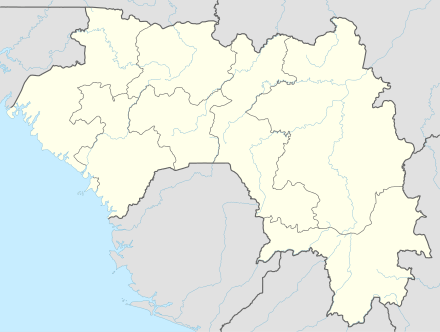Niani, Guinea
| Niani | |
|---|---|
| Village | |
 Niani Location in Guinea | |
| Coordinates: 11°22′47″N 8°23′03″W / 11.37972°N 8.38417°W | |
| Country |
|
| Region | Kankan Region |
| Prefecture | Kankan Prefecture |
| Time zone | UTC+0 (GMT) |
Niani is a village in Guinea. It is located in the Kankan Prefecture of the Kankan Region, in the east of the country. It lies on the left bank of the Sankarani River.[1]
Geography
The village is situated in extreme eastern Guinea, on the left bank of the Sankarani River. The river is accessible all year round and the village is surrounded by rocky peaks. The village is also on the edge of the forest, which is a source of gold, kola nuts, palm oil and ivory.[2]
History
Niani is often considered one of the ancient capitals of the Mali Empire and the birthplace of emperor Sundiata Keita. Some scholars believe that the village became the capital in the early 12th century after the former capital of Dioliba became abandoned.[1] Niani is mentioned by the 16th-century traveller Leo Africanus. While some scholars believe that Kangaba served as one of the capitals of the empire, others believe that Niani remained continuously the capital through the 14th to 16th centuries.[1] 14th century Arab historian Shihab al-Umari reported the village as Nyeni (Niani), saying it is "the official name of Mali ... because it is the capital of the regions of this kingdom."[2]
The city had at least 100,000 inhabitants in the 14th century.[3] The emperor (mansa) and his courtiers lived in Niani, which was a centre of trade and commerce.[4] The town developed as an outlet for two main trade routes, one northward, called the 'Mande route', and one southward, known as the 'Sarakolle route'.[2]
The emperor Musa I of Mali employed the Andalusian architect Ishak al-Tuedjin to build an audience chamber at Niani. It was "square, surmounted by a cupola, which he covered with plaster and decorated with arabesques in dazzling colours." It was an "admirable monument", according to 14th century North African historian Ibn Khaldun.[5]
After the Mali Empire declined during the 1600s, Niani lost its importance and became a small town again.[6]
In the 1920s archaeological excavations were carried out at Niani by Vidal and Gaillard which first identified the site. In 1965 and 1968 Guinean-Polish archaeological missions were carried out. These excavations revealed that the area around Niani was once densely populated.[1] The Arab quarter and royal town have been identified, specifically the foundations of stone houses, the mihrab of a mosque and the walls around the royal town.[2] The buildings were made of bricks of beaten earth, as al-Umari wrote, adding: "The ceilings are made of beams and reeds. They are mostly in the shape of a cupola [conical] or a camel's hump, like vaulted arches. The floors of the houses are of earth mixed with sand ... The king has a group of palaces surrounded by a circular wall."[2]
References
- 1 2 3 4 Imperato, Pascal James; Imperato, Gavin H. (2008-04-25). Historical Dictionary of Mali. Scarecrow Press. p. 231. ISBN 9780810864023.
- 1 2 3 4 5 Africa, Unesco International Scientific Committee for the Drafting of a General History of (1997-01-01). Africa from the Twelfth to the Sixteenth Century. University of California Press. p. 57. ISBN 9780520066991.
- ↑ Africa, Unesco International Scientific Committee for the Drafting of a General History of (1997-01-01). Africa from the Twelfth to the Sixteenth Century. University of California Press. p. 64. ISBN 9780520066991.
- ↑ Nwanunobi, C. Onyeka (1996-01-01). Malinke. The Rosen Publishing Group. p. 16. ISBN 9780823919796.
- ↑ Africa, Unesco International Scientific Committee for the Drafting of a General History of (1997-01-01). Africa from the Twelfth to the Sixteenth Century. University of California Press. p. 60. ISBN 9780520066991.
- ↑ Nwanunobi, C. Onyeka (1996-01-01). Malinke. The Rosen Publishing Group. pp. 16–17. ISBN 9780823919796.